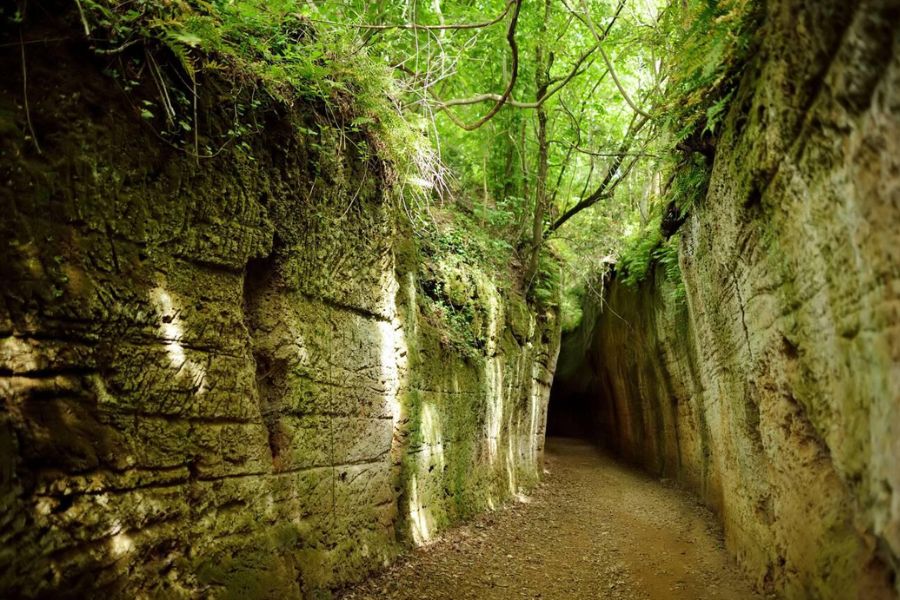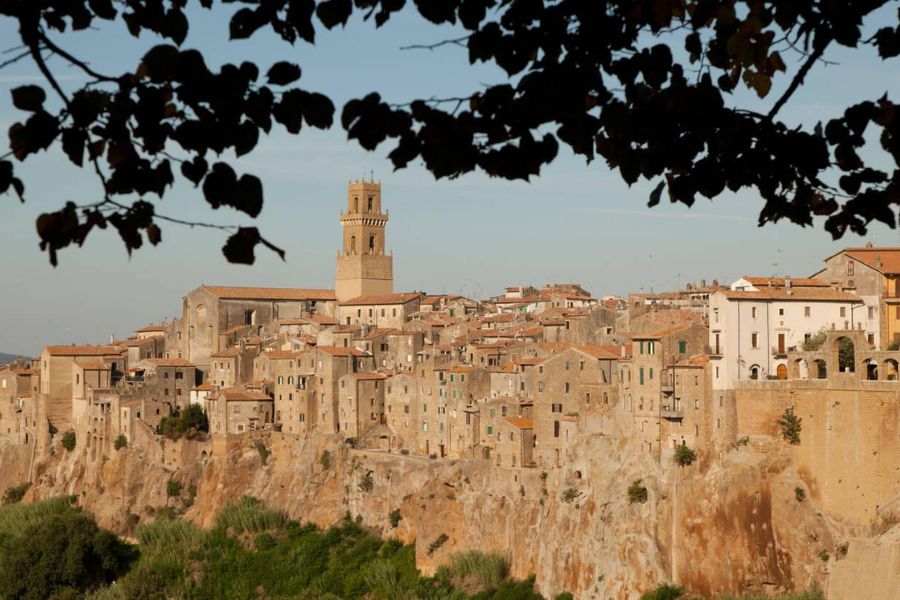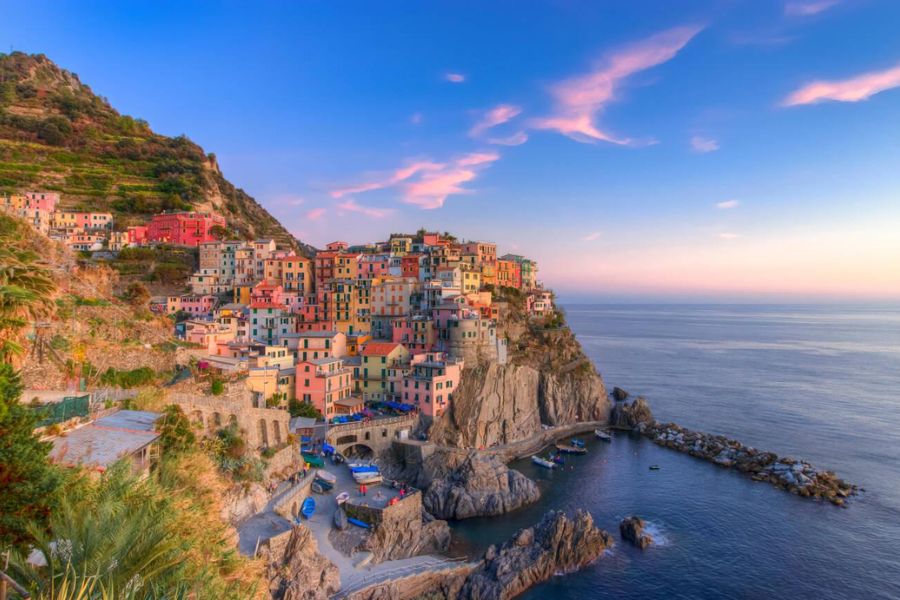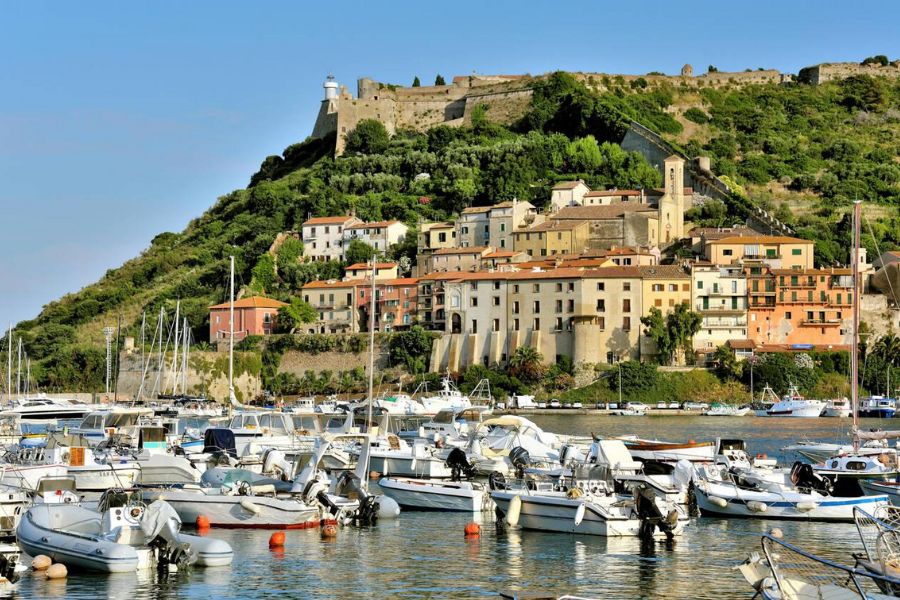Perched dramatically on a golden cliff, Pitigliano is one of Italy’s most captivating hidden gems. I stumbled upon this remarkable town during my travels through Tuscany last year and was immediately struck by its unique position.
The entire medieval village is carved directly into volcanic tuff rock, creating a seamless connection between human architecture and natural formation that’s unlike anywhere else in Europe.
Walking through Pitigliano feels like stepping into a fairytale. The ancient buildings seem to grow organically from the cliff itself, with warm-toned structures blending perfectly with the golden tuff stone beneath.
What makes this place truly special is how the village emerges suddenly from the lush green valleys where the Lente and Meleta rivers flow, creating a striking contrast between the rugged rock and verdant surroundings.
Locals often call Pitigliano “Little Jerusalem” due to its historic Jewish community that found sanctuary here centuries ago. I found myself wandering through narrow medieval streets, discovering hidden courtyards and unexpected viewpoints around every corner.

The late afternoon light bathes the tuff rock in a golden glow, making it the perfect time to explore this extraordinary village that defies conventional architecture and celebrates the remarkable relationship between human ingenuity and natural landscape.
The Fascinating History of Pitigliano
Perched on its dramatic tuff cliff, Pitigliano has a rich history spanning thousands of years. This golden-stone settlement has witnessed the rise and fall of civilizations while maintaining its unique character through the centuries.
Etruscan Roots and Medieval Charms
Walking through Pitigliano, I can feel the ancient Etruscan presence beneath my feet. The Etruscans first settled this area in the 9th century BC, carving homes and passages into the soft volcanic tuff rock. These early inhabitants recognized the strategic value of this elevated position.
When I explore the outskirts of town, I discover ancient pathways called “Vie Cave” – mysterious sunken roads cut deep into the tuff by Etruscan hands. These roads connect the settlement to nearby valleys and were likely used for both practical and ceremonial purposes.

The medieval period brought new layers to Pitigliano’s story. Wandering through the narrow streets, I’m surrounded by perfectly preserved medieval architecture. Stone houses seem to grow organically from the cliff face.
Pitigliano Through the Ages
During the Renaissance, Pitigliano flourished under the Orsini family who built the impressive fortress that still dominates the town’s skyline. I love exploring its ancient rooms and imagining life in this frontier town.
For centuries, Pitigliano stood as a border settlement between the Grand Duchy of Tuscany and the Papal States to the south. This unique position shaped its development and character.
The town earned the nickname “Little Jerusalem” due to its thriving Jewish community that settled here in the 16th century. I find it fascinating to visit the restored synagogue and explore the Jewish quarter with its bakery, kosher butchery, and ceremonial bath.

In the more recent past, Pitigliano became part of unified Italy in 1860. Today, this remarkable town preserves its layered history while welcoming visitors to discover its ancient stone houses and rich cultural heritage.
Exploring Pitigliano’s Unique Landscape
Pitigliano’s remarkable setting is like nothing else I’ve seen in Tuscany. The town emerges from volcanic rock in a way that makes it seem both part of nature and a triumph over it.
Tuff Rock Town and Its Natural Wonders
Walking through Pitigliano, I’m always amazed by how the town is literally carved from volcanic tuff stone. This golden-hued rock gives the buildings their distinctive warm glow, especially at sunset.
The entire settlement sits atop massive tuff cliffs in the Province of Grosseto. What makes this place truly special is how buildings seem to grow organically from the rock beneath them.
During my visits, I’ve discovered numerous caves and tunnels beneath the town. These aren’t just tourist attractions—they’re evidence of how generations of residents have worked with this unique landscape.

The surrounding countryside offers stunning contrasts to the tuff formations. Lush valleys and streams have carved deep gorges around the town over thousands of years, creating a dramatic natural setting that frames the human achievement above.
The Cliffside Village and Its Panoramas
Standing at Pitigliano’s edge, I’ve spent hours mesmerized by the panoramic views. The town perches dramatically on tuff spurs with sheer drops that create breathtaking vistas of the Tuscan countryside.
The best viewpoints are along the eastern edge where you can see how the buildings seem to balance precariously on the cliff’s edge. I recommend visiting at golden hour when the entire town glows with the same color as the tuff rock beneath it.
What I find most impressive is how the medieval architecture works with the natural contours of the cliff. Houses, churches, and fortifications follow the irregular rock formations rather than fighting against them.

From below, looking up at the town is equally stunning. The unified appearance of rock and building creates an unforgettable silhouette against the sky that I’ve photographed countless times but never quite captured fully.
Cultural Delights and Local Traditions
Pitigliano’s charm extends beyond its stunning tuff architecture into a vibrant cultural scene centered around food, wine, and communal celebrations. The town’s unique Jewish heritage and Etruscan roots have shaped traditions that visitors can experience through seasonal festivals and exceptional culinary offerings.
Wining and Dining in Pitigliano
The local cuisine in Pitigliano is a treasure waiting to be discovered. I found small family-run trattorias serving dishes that showcase the region’s agricultural bounty. The town’s signature dish is “sfratti,” honey-walnut cookies that tell the story of Jewish heritage through food.
Wine culture dominates the local experience. Vineyards surrounding Pitigliano produce exceptional whites, particularly from the Bianco di Pitigliano DOC. While exploring, I tasted these crisp whites alongside robust reds reminiscent of the nearby Brunello di Montalcino region.
For the best dining experiences, head to restaurants offering terraces with panoramic views. These al fresco dining spots perched on the tuff cliffs provide unforgettable meals as the sun sets over the Tuscan landscape.
Festivals and Cultural Events
Pitigliano’s calendar brims with celebrations that bring the town’s narrow streets to life. The most spectacular is “Torciata di San Giuseppe” in March, when residents carry flaming torches through town, culminating in a bonfire that symbolizes winter’s end.
September brings the wine harvest festival, when locals celebrate with tastings, music, and traditional foods. The event transforms the ancient streets into an open-air celebration of viticulture.
Jewish cultural events hold special significance, particularly during Hanukkah when the former ghetto comes alive with lights and concerts. The town’s museums host rotating exhibitions that highlight the diverse cultural influences that have shaped Pitigliano’s identity over centuries.

Local artisans open their workshops during specific festivals, offering demonstrations of traditional crafts like ceramics and woodworking that connect visitors to the town’s artistic heritage.
Travel Tips for the Ideal Pitigliano Experience
Planning a visit to this tuff-carved marvel requires some insider knowledge to make the most of your trip. I’ve gathered essential tips from my own travels to help you navigate this unique Tuscan gem.
Best Time to Visit and Weather Considerations
Spring (April-May) and early fall (September-October) offer the perfect balance of pleasant temperatures and fewer tourists in Pitigliano. I found mid-70s°F temperatures ideal for exploring the steep pathways without summer’s intense heat.
Summer brings warmth but also crowds, with July and August temperatures often climbing into the high 80s. Winter visits (November-March) mean fewer tourists, but some restaurants and shops operate on reduced hours.
The town’s elevation at 1,026 feet creates slightly cooler temperatures than coastal Tuscany. I always pack a light jacket even in summer, as evenings can be surprisingly cool. Rain is most common in October and November, so bring an umbrella if traveling then.
Accommodation and Amenities
Staying within Pitigliano’s historic center provides the most authentic experience. I’ve found several charming B&Bs and vacation rentals tucked into medieval buildings that offer reasonable rates compared to more famous Tuscan destinations.
For modern amenities, look for properties that have been thoughtfully renovated while maintaining historic character. Many accommodations offer:
- Free WiFi
- Air conditioning (essential in summer)
- Kitchenettes for self-catering
- Rooftop terraces with stunning views
Most properties in the historic center have stairs and limited accessibility. If you need wheelchair access, I recommend staying at newer properties on the town’s outskirts with modern facilities.

Don’t expect luxury chain hotels here—Pitigliano’s charm lies in its family-run accommodations with personal touches and local insights from hosts.
Navigating the Village
Pitigliano’s historic center is entirely pedestrian, with narrow, sometimes steep pathways carved into tuff. I recommend wearing comfortable, sturdy shoes with good traction, especially after rain when the stone surfaces can be slippery.
Park your car in one of the designated lots outside the historic center. The main parking area near Via Caduti Sul Lavoro charges a small fee but offers convenient access to the town.
The village is small enough to explore in a day, but I suggest taking your time to discover:
- The Jewish Quarter and its fascinating history
- Hidden Etruscan pathways carved into the rock
- Panoramic viewpoints along the outer edges

Consider hiring a local guide for the first few hours. They’ll reveal hidden spots and share stories you’d likely miss on your own. Most paths are manageable for moderate fitness levels, but some sections require climbing steps.
Beyond Pitigliano: Day Trips and Nearby Attractions
While exploring Pitigliano is captivating, the surrounding area offers incredible destinations that deserve your attention. The nearby villages, countryside, and thermal baths create perfect opportunities for unforgettable day trips from your Tuscan base.
Sorano and Sovana: Pitigliano’s Sister Villages
Just a short drive from Pitigliano, I discovered the equally charming tuff towns of Sorano and Sovana. These villages form what locals call the “tuff triangle” with Pitigliano.
Sorano clings dramatically to its rocky perch, with narrow medieval streets winding through the village. Its impressive fortress, Fortezza Orsini, offers spectacular views of the surrounding valleys.
Sovana surprised me with its incredible preservation. This tiny hamlet features a magnificent Etruscan necropolis and a beautiful Romanesque cathedral. I spent hours wandering its perfectly restored center, admiring the ancient stone buildings and soaking in the authentic atmosphere.
Both villages showcase the same tuff stone architecture as Pitigliano but with their own distinct character and fewer tourists.
Discoveries in the Maremma Countryside
The wild Maremma region surrounding Pitigliano offers breathtaking landscapes and hidden treasures. I found this area perfect for leisurely drives through rolling hills dotted with cypress trees.
Several ancient Etruscan sites hide among the countryside, with mysterious carved pathways known as “vie cave” connecting them. These sunken roads, carved deep into the tuff rock, create an otherworldly hiking experience.
Lake Bolsena, Italy’s largest volcanic lake, lies just a short drive away. The charming town of Bolsena sits on its shores, offering fresh lake fish and beautiful beaches.

I particularly enjoyed exploring the small villages scattered throughout the region. Each has its own specialty, whether it’s wine, olive oil, or local cheeses.
Thermal Bliss at the Natural Baths
One of my favorite discoveries near Pitigliano was the abundance of natural thermal baths. This volcanic region is blessed with healing mineral waters that have attracted visitors since Etruscan times.
The most accessible are the Saturnia hot springs. Warm sulfurous water cascades over natural rock formations and creates the famous “Cascate del Mulino.” These free-access pools maintain a constant 37.5°C (99.5°F) temperature year-round.

For a more upscale experience, I visited San Casciano dei Bagni. This elegant town features both luxury spas and rustic natural pools hidden in the countryside.
The thermal waters offer therapeutic benefits for skin conditions and muscle pain. I found nothing more relaxing than soaking in these warm pools while gazing at the stunning Tuscan landscape.

